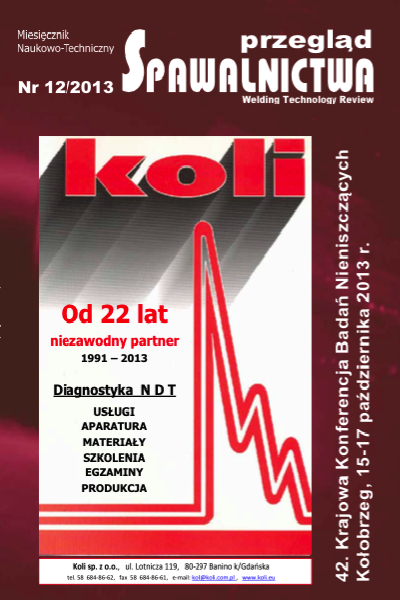Metoda tomografii ultradźwiękowej próba nieniszczącej lokalizacji zbrojenia w elemencie betonowym
Main Article Content
Abstract
W artykule przedstawiono próbę nieniszczącej lokalizacji zbrojenia w elemencie betonowym z zastosowaniem nowoczesnej nieniszczącej metody badawczej tomografii ultradźwiękowej. Metoda ta nie jest wprawdzie przeznaczona do lokalizacji zbrojenia, ale podczas testów laboratoryjnych otrzymano interesujące wyniki, które zamieszczono w niniejszej pracy. Były to sygnały, jakie otrzymano dla próbki betonowej wykonanej w laboratorium, w której umieszczono zamodelowaną siatkę prętów zbrojeniowych. Analiza uzyskanych rezultatów wykazała, że jest możliwe określenie lokalizacji siatki zbrojeniowej za pomocą metody tomografii ultradźwiękowej, ale do głębokości ok.200 mm elementu betonowego. Zwrócono uwagę, że potrzebe większej liczby takich sygnałów (zobrazowań) wzorcowych, które mogą być przydatne do monitoringu i diagnostyki obiektów wykonanych z betonu.
Ultrasonic tomography method non-destructive testing of location reinforcement in the concrete element
abstract
The paper presents the location of the non-destructive test of reinforcement in concrete element with the use of modern non-destructive testing method of ultrasonic tomography. This method is indeed dedicated to the location of the reinforcement, but during laboratory tests gave interesting results, which are presented in this paper. There were signals that were obtained for the samples of con- crete performed in the laboratory, which provided a grid of reinforcing bars modeled. Analysis of the results showed that it is possible to determine the location of the reinforc- ing fabric by the method of ultrasonic tomography, but to a depth of about 200 mm of the concrete element. It was noted that there is a need to develop more of these signals (imaging) model, which can be useful for monitoring and diagnosis of buildings made of concrete.
Downloads
Article Details
Creative Commons CC BY 4.0 https://creativecommons.org/licenses/by/4.0/
Welding Technology Review (WTR) articles are published open access under a CC BY licence (Creative Commons Attribution 4.0 International licence). The CC BY licence is the most open licence available and considered the industry 'gold standard' for open access; it is also preferred by many funders. This licence allows readers to copy and redistribute the material in any medium or format, and to alter, transform, or build upon the material, including for commercial use, providing the original author is credited.
References
Bishko A. V., Samokrutov A. A, Shevaldykin V. G.: Ultrasonic echopulse tomography of concrete using shear waves lowfrequency phased antenna arrays. e-Journal of non-destructive Testing & Ultrasonics, vol. 13, 2008.
Hola J., Schabowicz K., State-of-the-art nondestructive me- thods for diagnostics testing of building structures anticipated development trends, Archives of Civil and Mechanical Engineering, 11, 2010.
Kozlov V.N., SamokrutovA.A., ShevaldykinV.G.: Thickness Measurements and Flaw Detection in Concrete Using Ultrasonic Echo Method. J. nondestructive Testing and Evaluation, 1997, vol. 13, s. 73 - 84.
Samokrutov A. A., Kozlov V. n., Shevaldykin V. G.: Ultrasonic testing of concrete objects using dry acoustic contact. Methods, instruments and possibilities. The 5th International Conference ‚‚Non-Destructive Testing and Technical Diagnostics in Industry. Mashinostroenie, 2006, s.152.
Schabowicz K., Hoła J.: nondestructive elastic-wave tests of foundation slab in office building, 13th Asia-Pacific Conference on Non-Destructive Testing, Yokohama, Japan, 2009.
Schabowicz K., Hoła J., Styś D.: Nondestructiveelastic-wave tests of concrete in foundation slab, 10th European Conference on nondestructive Testing, Moscow, Russia, 2010.
Schabowicz K., Hoła J., nondestructive elastic-wave tests of foundation slab in office building, Materials Transactions, 53, 2012, s. 296-302.
